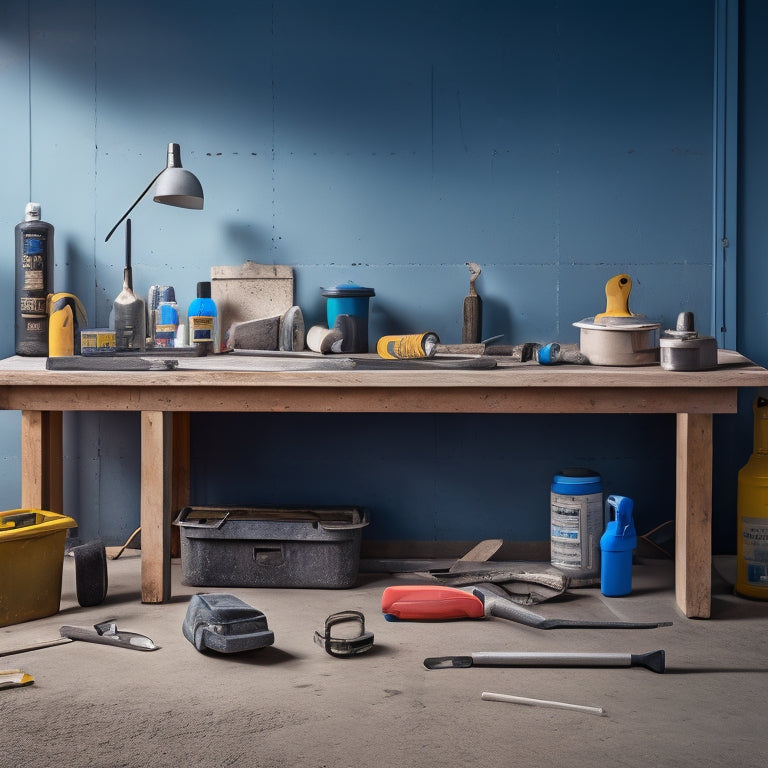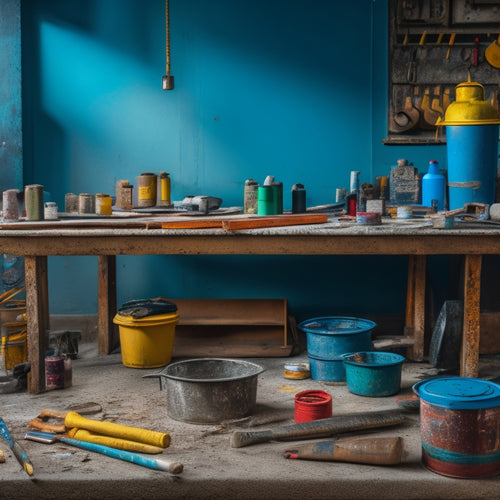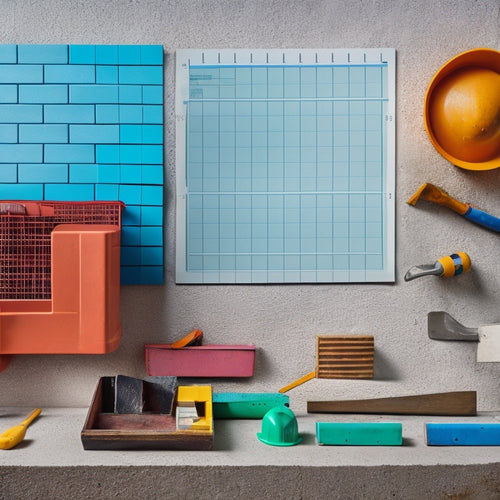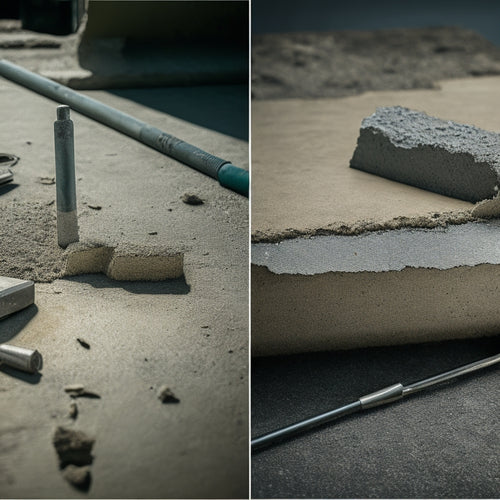
Selecting the Right Tools for Concrete Wall Sealing
Share
When selecting the right tools for concrete wall sealing, you'll need a strategic arsenal to guarantee success. Start by choosing the right preparation tools, such as scarifiers or grinders, to achieve an ideal surface texture. Next, select application tools like brushes, rollers, or sprayers based on sealant type and viscosity. Don't forget to ponder temperature, moisture, and surface compatibility when making your tool selection. Additionally, prioritize safety with personal protective equipment and measuring/testing tools like moisture meters, surface profilers, and pH meters. By covering these bases, you'll be well on your way to a successful seal - and there's even more to explore to ensure a job well done.
Key Takeaways
- Choose preparation tools like scarifiers or grinders to achieve the ideal surface texture for sealant adhesion.
- Select debris removal tools like stiff-bristled brooms or power washers to clean the surface thoroughly.
- Ensure chemical compatibility and eco-friendliness when selecting cleaning solutions to avoid damaging surfaces.
- Match tool size to project scale and select applicators based on sealant type and viscosity for efficient application.
- Consider surface porosity, desired finish, and technique mastery when choosing the right sealant applicator for the job.
Sealing Concrete Walls With Ease
Get ready to tackle the task of sealing your concrete walls with confidence. You've chosen the right tools, now it's time to put them to use. Sealing concrete walls requires attention to detail and a solid understanding of waterproofing techniques.
Start by preparing the surface, ensuring it's clean and free of debris. Next, apply a coat of primer to create a strong bond between the wall and sealant. Once the primer is dry, it's time to apply the sealant. Work in sections, using a consistent, even motion to cover the entire surface.
Make sure to follow the manufacturer's instructions for application thickness and drying time. Proper wall maintenance is vital to extending the life of your sealant. Regularly inspect your walls for signs of damage or wear, addressing issues promptly to prevent water intrusion.
Essential Tools for Sealing Success
You'll need the right tools to guarantee a successful concrete wall sealing project.
To achieve this, you'll focus on three critical areas: preparing the sealing surface, applying sealants effectively, and inspecting and cleaning up afterwards.
Sealing Surface Preparation
Sealing surface preparation is a critical step in the concrete wall sealing process, as it directly impacts the success of the sealant application. You must guarantee the surface is clean, dry, and free of contaminants that could compromise the sealant's adhesion.
Inspect the surface for cracks, voids, and other defects that may require repair before sealing. The surface texture also plays a significant role in sealant performance. A rough surface can increase the risk of sealant failure, while a smooth surface can improve adhesion.
You may need to use specialized tools, such as scarifiers or grinders, to achieve the ideal surface texture. Moisture control is another essential aspect of surface preparation. Excessive moisture can prevent the sealant from bonding properly, leading to premature failure.
You must guarantee the surface is dry and free of standing water before applying the sealant. Use moisture meters or other testing devices to determine the surface's moisture levels and take corrective action if necessary.
Sealant Application Methods
With the surface properly prepared, it's time to move on to the sealant application process, where the right tools can make all the difference.
When selecting application techniques, consider the type of sealant you're working with. For example, low-viscosity sealants are best applied with a brush or roller, while high-viscosity sealants require a squeegee or trowel. You'll also need to choose the right size and type of tool for the specific job. A smaller brush may be better suited for detail work, while a larger roller is ideal for covering large areas.
Different sealant types also require specific application tools. For instance, silane-based sealants are often applied with a low-pressure sprayer, while acrylic-based sealants are best applied with a brush or roller.
Additionally, consider the substrate temperature and porosity when selecting application techniques. By choosing the right tool for the job, you'll guarantee a successful sealant application that meets the project's requirements.
Inspection and Cleanup
After applying the sealant, turn your attention to inspecting the concrete wall to verify a successful seal.
You'll need to conduct a thorough surface assessment to confirm the sealant has been applied evenly and effectively. This involves visually examining the wall for any signs of defects, such as bubbles, cracks, or uneven coverage.
You should also perform a mold inspection to identify any areas where mold or mildew may be present, as these can compromise the sealant's effectiveness.
During the inspection, pay particular attention to areas around joints, cracks, and other potential weak points in the wall.
Use a high-intensity light source to illuminate any dark or hard-to-reach areas.
If you find any defects or issues, address them promptly by re-applying the sealant as needed.
Choosing the Right Sealant Applicator
Choosing the Right Sealant Applicator
How do you guarantee a uniform, professional-looking sealant application? It starts with selecting the right sealant applicator for your concrete wall sealing project. You need to take into account the type of sealant, the surface preparation, and the desired finish. There are various applicator types and techniques to choose from, and the right combination will guarantee a successful application.
| Applicator Type | Suitable For | Applicator Technique |
|---|---|---|
| Brush Applicator | Small areas, detail work | Use gentle strokes to work sealant into surface |
| Roller Applicator | Large areas, smooth surfaces | Apply consistent pressure, maintain even speed |
| Spray Applicator | Large areas, textured surfaces | Hold sprayer at 10-12 inches, move in steady passes |
When choosing an applicator, take into account the viscosity of the sealant, the porosity of the concrete, and the desired finish. For example, a brush applicator is ideal for small areas and detail work, while a roller applicator is better suited for large areas and smooth surfaces. By selecting the right applicator and mastering the applicable technique, you'll achieve a uniform, professional-looking sealant application.
Proper Cleaning Tools for Preparation
When preparing a concrete wall for sealing, you'll need to start with a clean surface.
First, you'll want to remove any loose debris.
Then select the right cleaning solution for the job, and finally, scrub away any tough stains that remain.
Remove Loose Debris First
Precision is key when preparing a concrete wall for sealing, and it begins with a thorough removal of loose debris. You'll need to remove dirt, dust, and other particles that can interfere with the sealing process. This step is essential, as any remaining debris can compromise the sealant's adhesion and lead to premature failure.
To accomplish this, you'll need the right tools for debris removal. Start with a stiff-bristled broom or a wire brush to sweep away loose particles. For more stubborn debris, consider using a power washer or a scrub brush.
Be sure to inspect the surface carefully, paying attention to corners, crevices, and other areas where debris tends to accumulate.
During surface inspection, look for signs of wear, cracks, or other damage that may require additional preparation before sealing. A thorough debris removal process sets the stage for a successful sealant application, ensuring a strong bond between the concrete and the sealant.
Choose Right Cleaning Solution
After removing loose debris, you're ready to tackle the next step in preparing your concrete wall for sealing: selecting the right cleaning solution. This is a vital step, as the wrong solution can compromise the sealant's adhesion or even damage the wall itself.
When choosing a cleaning solution, prioritize eco-friendly solutions that are gentle on the environment and won't harm your skin or respiratory system.
Chemical compatibility is also significant. Make sure the cleaning solution won't react with the sealant or any existing coatings on the wall. Read the labels carefully and look for solutions specifically designed for concrete preparation.
Avoid using harsh chemicals, abrasive cleaners, or acids, as they can etch the surface or leave behind residues that interfere with the sealant.
Select a solution that effectively removes dirt, grime, and other substances without leaving behind a residue. You may need to experiment with different solutions to find the one that works best for your specific wall.
Scrub Away Tough Stains
Because your concrete wall may still harbor stubborn stains or imperfections, you'll need the right tools to scrub them away effectively.
Even with the right cleaning solution, tough stains require specialized tools to remove them completely. Investing in the correct scrubbing tools will help you master stain removal techniques and achieve a smooth, even surface for concrete surface treatments.
Use these essential tools to scrub away tough stains:
- Stiff-bristled brushes: Ideal for aggressive scrubbing of heavy stains and rough surfaces
- Wire brushes: Effective for removing rust, oil, and grease stains
- Nylon scrubbers: Gentle on surfaces, yet tough on stains, making them perfect for delicate areas
- Steel wool pads: Excellent for removing stubborn stains and rust from metal surfaces
- Abrasive pads: Useful for removing heavy deposits and imperfections from concrete surfaces
Safety Equipment for Protection
Your personal protective equipment (PPE) is the first line of defense against potential hazards when sealing concrete walls. You must prioritize safety protocols to prevent injuries and guarantee a successful project.
Your PPE should include gloves, safety glasses, and a face mask to protect you from harsh chemicals and debris. Steel-toed boots and a hard hat are also essential for protecting your feet and head from falling objects.
When working with sealers, you'll need to handle chemicals that can be hazardous to your health. Wear chemical-resistant gloves and a respirator to prevent skin contact and inhalation of toxic fumes.
Make sure you have a first aid kit on site and know basic first aid procedures in case of an emergency. Additionally, guarantee good ventilation in the work area to prevent the buildup of fumes.
Measuring and Testing Tools Required
Measure the concrete wall's surface accurately to determine the correct amount of sealer needed.
You'll need to assess the wall's surface texture, porosity, and moisture levels to choose the right sealer and application method.
To do this, you'll require the following measuring and testing tools:
- Moisture meters: for accurate moisture measurement, ensuring the wall is dry enough for sealing
- Surface profilers: to assess the wall's surface texture, helping you determine the correct sealer viscosity
- Thermocouples: to measure temperature, which affects sealer application and drying times
- pH meters: to test the wall's pH levels, ensuring the sealer is compatible with the concrete
- Covermeter: to measure the wall's thickness, allowing you to calculate the correct amount of sealer needed
Frequently Asked Questions
Can I Use a Regular Broom for Sweeping the Concrete Wall?
You shouldn't use a regular broom for sweeping the concrete wall, as it can scratch or damage the surface. Instead, opt for a soft-bristled or nylon-bristle broom specifically designed for wall cleaning, ensuring a gentle and effective cleaning process.
Are All Concrete Sealants Suitable for Exterior Wall Applications?
You might think all sealants are created equal, but that's not the case. When it comes to exterior walls, you'll need sealants that can withstand harsh weather conditions, unlike interior sealants. Consider temperature considerations, such as freeze-thaw cycles, to guarantee the right choice.
How Often Should I Reapply Concrete Sealant to Maintain Effectiveness?
You'll need to reapply concrete sealant based on its sealant longevity, typically every 5-10 years, depending on environmental factors and traffic; however, you may need to adjust application frequency if you notice premature wear or degradation.
Can I Seal a Damp or Wet Concrete Wall Without Issues?
Picture a medieval knight battling moisture; you're about to face a similar quest. Unfortunately, you can't seal a damp or wet concrete wall without issues - it's a recipe for disaster. Instead, focus on moisture control and master advanced sealing techniques to guarantee a successful, long-lasting seal.
Do I Need to Seal the Entire Wall or Just the Cracks?
When addressing dampness, you'll want to seal the entire wall to prevent moisture from seeping through, but if focusing on crack repair, targeting just the cracks can be sufficient for effective moisture prevention.
Conclusion
You've got the right tools, and you're ready to seal your concrete wall with confidence. According to the American Concrete Institute, 95% of concrete walls require some form of repair or restoration within the first 10 years of construction. Don't let your wall become a statistic - with the right tools and techniques, you can guarantee a strong, durable, and long-lasting seal that will protect your wall for years to come.
Related Posts
-

Essential Tools for Painting Concrete Walls
When painting concrete walls, you'll need a range of specialized tools to achieve a professional-looking finish. Star...
-

Reinforcement Tools Checklist for Concrete Block Walls
You'll need a range of reinforcement materials, including horizontal and vertical rebar, fiber mesh, and anchor bolts...
-

Top Tools for Concrete Adhesion Success
When it comes to concrete adhesion success, you'll need to wield the right tools and techniques to guarantee a strong...


